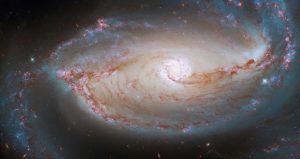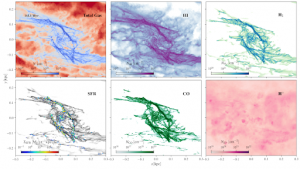
The central regions of galaxies can be extremely dynamic and highly complex. Most galaxies host a super massive black hole (SMBH) at their very centre and gas accretion onto this object will power active galactic nuclei (AGN), which are among the most energetic phenomena in our Universe. The energy released by the accretion of gas onto the SMBH may be sufficiently high to have a significant impact on the future evolution of the host galaxy.
Galaxy encounters and mergers can, for instance, trigger significant gas inflows towards central regions, fueling the SMBH and igniting a burst of star formation as well as AGN activity. But also isolated galaxies can have efficient ways of driving gas towards the inner regions. Stellar discs are generally prone to developing an instability, which leads to the formation of a non-axisymmetric central barred structure – present in a large fraction of observed disc galaxies, including our Milky Way. Bars can efficiently remove angular momentum from the gas in the disc, funnelling it towards the centre. This inflowing gas often accumulates in a ring-like structure on small scales, where the bar is not able to further remove its angular momentum, likely leading to a region with intense formation of new stars. Related central gas densities are significantly higher compared to that in the disc component, magnetic fields are extreme, and collisions of gas clouds are frequent due to the short orbital times, and the bar-driven inflow of high-velocity clouds. Moreover, if present, the energies released by the central AGN and young stars can also affect the surrounding gas, generating complex feedback loops involving these different mechanisms.
At GalSpec, we conduct high-resolution, numerical simulations to robustly study gas flows in the central region of galaxies to understand (i) which processes dominate the gas dynamics in such extreme environments, (ii) how gas is fuelled towards a central SMBH, and (iii) how released energy from both the central SMBH and young stars is coupling to the surrounding interstellar medium. Such detailed, high-resolution simulations are of high value to stress-test current theories for star formation as well as stellar and AGN feedback against observations of our Milky Way galaxy and other nearby galaxies.
